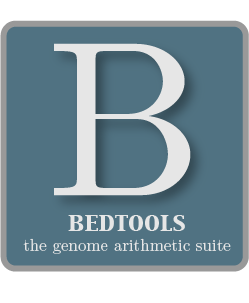3. Quick start¶
3.1. Install bedtools¶
curl http://bedtools.googlecode.com/files/BEDTools.<version>.tar.gz > BEDTools.tar.gz
tar -zxvf BEDTools.tar.gz
cd BEDTools
make
sudo cp bin/* /usr/local/bin/
3.2. Use bedtools¶
Below are examples of typical bedtools usage. Using the “-h” option with any bedtools will report a list of all command line options.
Report the base-pair overlap between the features in two BED files.
bedtools intersect -a reads.bed -b genes.bed
Report those entries in A that overlap NO entries in B. Like “grep -v”
bedtools intersect -a reads.bed -b genes.bed -v
Read BED A from STDIN. Useful for stringing together commands. For example, find genes that overlap LINEs but not SINEs.
bedtools intersect -a genes.bed -b LINES.bed | \
bedtools intersect -a stdin -b SINEs.bed -v
Find the closest ALU to each gene.
bedtools closest -a genes.bed -b ALUs.bed
Merge overlapping repetitive elements into a single entry, returning the number of entries merged.
bedtools merge -i repeatMasker.bed -n
Merge nearby repetitive elements into a single entry, so long as they are within 1000 bp of one another.
bedtools merge -i repeatMasker.bed -d 1000
